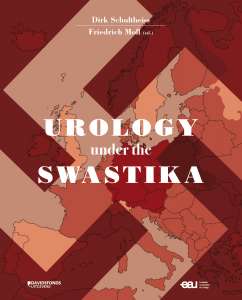EAU History Office presents new research into urology’s ‘darkest days: Urology Under the Swastika

The rise of national socialism and fascism in Europe and the subsequent occupation of the continent during the Second World War dramatically influenced and ruined the careers of urologists and with it the development of urology as an emerging medical specialty.
In 1933, in Germany alone around a third of urologists were Jewish or otherwise connected to the Jewish community. The 1930s and 1940s saw European urologists dealing with the rapidly changing political situation, including collaboration, forced exile and even death.
The EAU History Office is launching its latest book Urology Under the Swastika at EAU17. It explores the history of European urologists and urology in the period of the Nazi rule in Germany and the countries it subsequently occupied. We spoke to its editors, former EAU History Office Chairman Prof. Dirk Schultheiss (Giessen, DE) and Dr. Friedrich Moll (Cologne, DE).
Urology Under the Swastika documents the fates of urologists in this period and explores the effects of the Second World War on urology. The complicity and involvement of physicians and medical societies under the influence of national socialism and fascism is presented in a wide range of chapters that cover several European countries and other continents. The dynamics that changed urology, both similar and vastly different across the continent are based on new research and previously unknown sources.
Project’s origins
These important issues first received attention from urologists and medical historians in Germany and Austria through an earlier research project of the German Society of Urology or Deutsche Gesellschaft für Urologie (DGU), published in 2011.
Prof. Schultheiss: “From the publication of the DGU books on, I’ve been trying to motivate both urologists and historians in their respective countries to research the topic. We’ve managed to assemble experts through our own office members and other partners. The last group to join was the Israeli team, which joined last summer and did a great job in that brief time.”
The chapters of the book cover most European countries individually, but also some countries where (Jewish) urologists fled to such countries as the United Kingdom, the United States, Argentina and the aforementioned Israel.
Effects on urology
A large percentage of urological surgeons and related professions in 1930s Europe were Jewish or of Jewish origin. As the Nazi party came to power in Germany (and then Europe), their rights to practice medicine were restricted and, eventually, revoked.
“Urology, like dermatology and pediatrics had the highest percentage of Jewish doctors in Germany and Austria,” Schultheiss explained. “Among them were several of the world’s most prominent researchers. Their elimination from active work and research caused a loss of expertise and weakened the newly emerging speciality of urology.”
The doctors who did not immigrate to safer countries were ultimately killed in camps or in some cases received exemption as they treated soldiers or otherwise were of value to their respective country or army. Urology Under the Swastika explores the individual stories of several notable surgeons, as well as the field as a whole.
Schultheiss: “Aside from the very personal tragedies, we can also draw some conclusions about the field of urology as a whole. Generally speaking, the outbreak of the Second World War and subsequent occupation severely limited research and scientific exchange between European countries. National and international medical congresses were postponed or cancelled.”
In addition to urology, the book touches on topics like eugenics, sexology and forced sterilization: all issues that were seized by Nazi science and relied on urologists to assist them. The collusion with power that some urologists chose or were forced to choose sets an example for medical practitioners to this day:
“As urologists we still have to be very sensitive when medical practice and the power of politics or economics come together. The extreme cases of the 1930s and 1940s as depicted in certain chapters of this book should keep us all vigilant,” Schultheiss reflected.
Research and the divided continent
Co-editor Dr. Moll placed this Europe-wide research project into some historical context: “the status of historic research into these events differs very much across our continent. In some cases, we can build on extensive research into medicine during the War, but in others we had to rely on personal research and first- or second-hand accounts of urologists’ experiences in this period.”
“You must also not overlook the devastating (global) economic crisis of the 1920s and ethnic conflicts within newly established countries when investigating the state of urology. The long-term consequences of the First World War were felt throughout the following decades, eventually leading to the start of the Second World War.”
In stark contrast to today, the continent and its urologists were far from united at that time. Moll: “The effects on urology and urologists of the rapidly changing political situation differ vastly from country to country. We hope that Urology Under the Swastika reflects this huge diversity and will prompt our colleagues to reflect on this painful period in our field.”
- Urology Under the Swastika is one of the membership benefits at EAU17 and can be collected at the EAU Booth (G50) in the Exhibition
- Urology Under the Swastika will be presented and discussed during the second part of the Special Session of the History Office, Saturday 25 March at 8:30-11:30, Room 9, Capital Suite (Level 3).

